Abstract
Objective—To analyse the changes in mortality in dilated cardiomyopathy over the past 15 years and to identify the factors that might have influenced survival. Design—Follow up study of 235 patients (aged 16-70) systematically enrolled on a register from 1 January 1978 to 31 December 1992.
Setting—Hospital department of cardiology.
Patients—Three groups corresponding to three periods of 5 years: group 1 (diagnosis between 1 January 1978 and 31 December 1982) 26 patients; group 2 (diagnosis between 1 January 1983 and 31 December 1987) 65 patients; and group 3 (diagnosis between 1 January 1988 and 31 December 1992) 144 patients.
Main outcome measures—Death or heart transplantation.
Results—Two and four year survival was 73·8% and 53·8% in group 1, 87·7% and 72·3% in group 2, and 90·3% and 82·9% in group 3 (P = 0·02). During the 15 years of the study period the number of cases increased progressively and the baseline clinical characteristics changed (that is, patients were younger and less severely affected), partly explaining the improvement in survival. None the less, the three mortality curves tended to diverge progressively and the improvement in survival in the different groups was still significant after stratification for the severity of the disease, suggesting that treatment had a sustained effect. A progressively higher proportion of patients were treated with angiotensin converting enzyme (ACE) inhibitors and more recently with β blockers. In group 2, after stratification for the severity of heart failure, patients who were treated with ACE inhibitors showed a better survival than patients who were not. Furthermore, analysis of group 3 showed that β blockers had a significant additive effect with conventional therapy both by intention to treat and actual treatment. Four year survival in patients with mild and moderate to severe heart failure treated with β blockers, and usually digitalis and ACE inhibitors, was respectively 90% and 87·5%.
Conclusions—The improvement in the survival of patients with dilated cardiomyopathy over the past 15 years may be explained by earlier diagnosis, new treatments, and a change in the clinical characteristics of the patients at enrolment.
Full text
PDF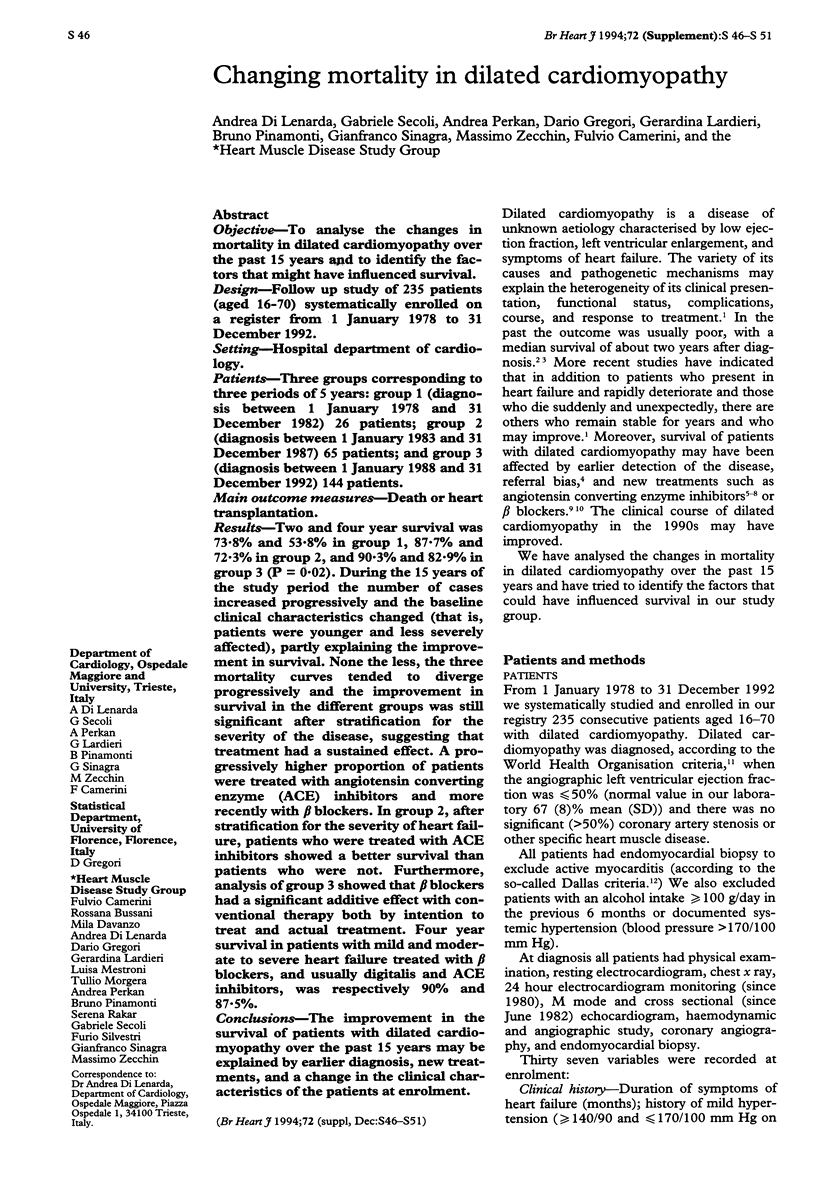
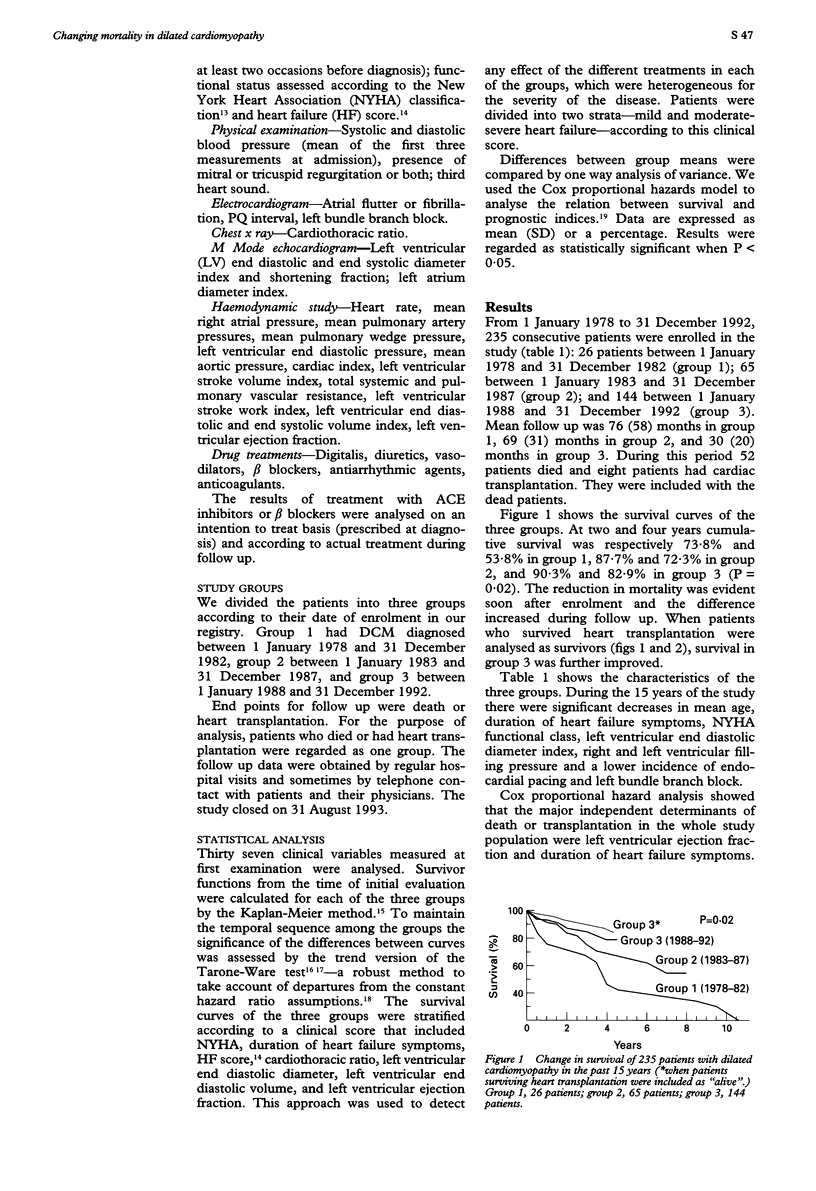
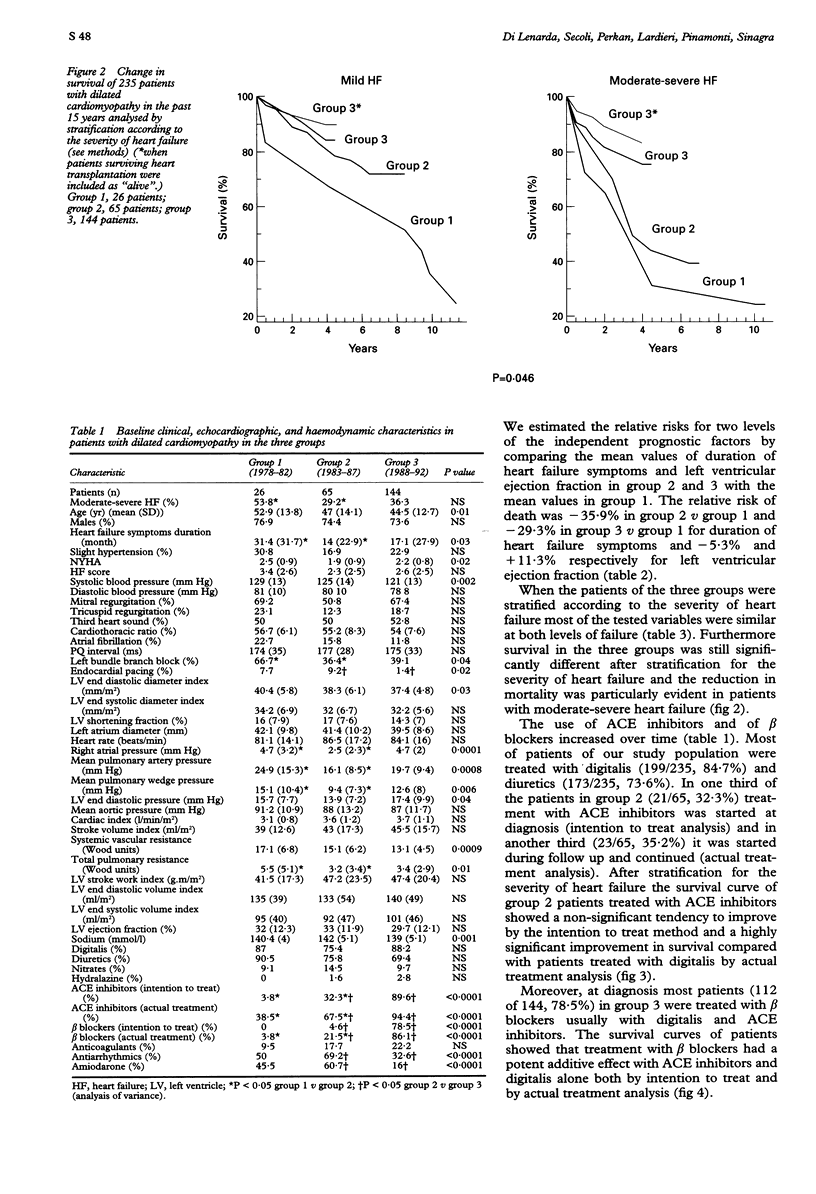
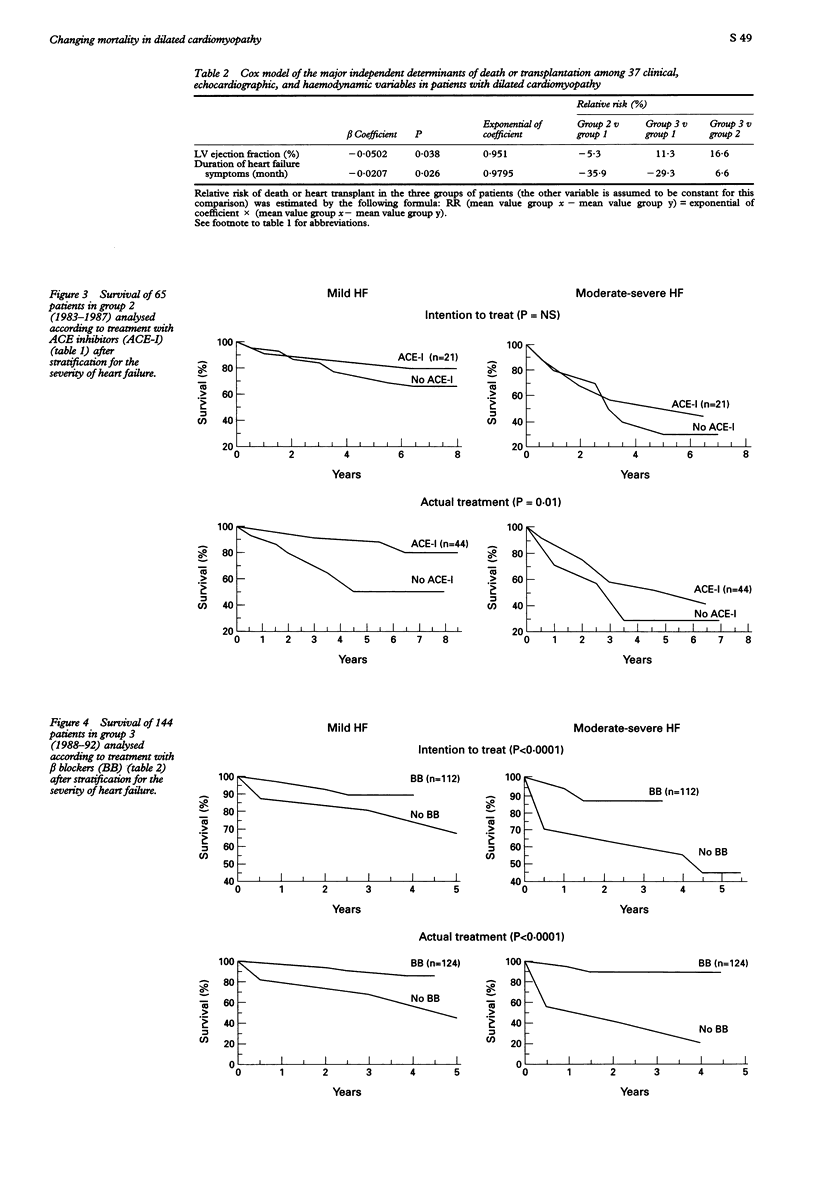
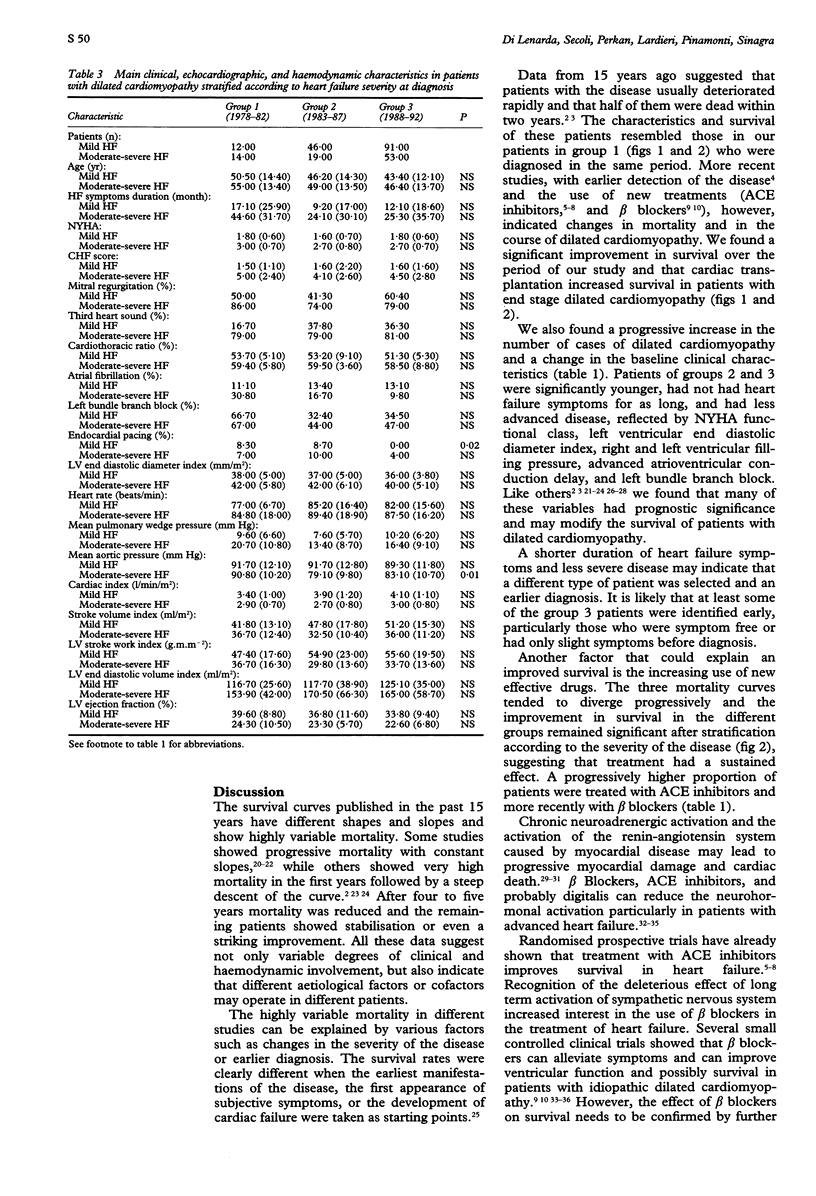

Selected References
These references are in PubMed. This may not be the complete list of references from this article.
- Anderson J. L., Lutz J. R., Gilbert E. M., Sorensen S. G., Yanowitz F. G., Menlove R. L., Bartholomew M. A randomized trial of low-dose beta-blockade therapy for idiopathic dilated cardiomyopathy. Am J Cardiol. 1985 Feb 1;55(4):471–475. doi: 10.1016/0002-9149(85)90396-0. [DOI] [PubMed] [Google Scholar]
- Aretz H. T., Billingham M. E., Edwards W. D., Factor S. M., Fallon J. T., Fenoglio J. J., Jr, Olsen E. G., Schoen F. J. Myocarditis. A histopathologic definition and classification. Am J Cardiovasc Pathol. 1987 Jan;1(1):3–14. [PubMed] [Google Scholar]
- Cohn J. N., Johnson G., Ziesche S., Cobb F., Francis G., Tristani F., Smith R., Dunkman W. B., Loeb H., Wong M. A comparison of enalapril with hydralazine-isosorbide dinitrate in the treatment of chronic congestive heart failure. N Engl J Med. 1991 Aug 1;325(5):303–310. doi: 10.1056/NEJM199108013250502. [DOI] [PubMed] [Google Scholar]
- Cohn J. N., Levine T. B., Olivari M. T., Garberg V., Lura D., Francis G. S., Simon A. B., Rector T. Plasma norepinephrine as a guide to prognosis in patients with chronic congestive heart failure. N Engl J Med. 1984 Sep 27;311(13):819–823. doi: 10.1056/NEJM198409273111303. [DOI] [PubMed] [Google Scholar]
- Diaz R. A., Obasohan A., Oakley C. M. Prediction of outcome in dilated cardiomyopathy. Br Heart J. 1987 Oct;58(4):393–399. doi: 10.1136/hrt.58.4.393. [DOI] [PMC free article] [PubMed] [Google Scholar]
- Franciosa J. A., Wilen M., Ziesche S., Cohn J. N. Survival in men with severe chronic left ventricular failure due to either coronary heart disease or idiopathic dilated cardiomyopathy. Am J Cardiol. 1983 Mar 1;51(5):831–836. doi: 10.1016/s0002-9149(83)80141-6. [DOI] [PubMed] [Google Scholar]
- Fuster V., Gersh B. J., Giuliani E. R., Tajik A. J., Brandenburg R. O., Frye R. L. The natural history of idiopathic dilated cardiomyopathy. Am J Cardiol. 1981 Mar;47(3):525–531. doi: 10.1016/0002-9149(81)90534-8. [DOI] [PubMed] [Google Scholar]
- Gavazzi A., Lanzarini L., Cornalba C., Desperati M., Raisaro A., Angoli L., De Servi S., Specchia G. Dilated (congestive) cardiomyopathy. Follow-up study of 137 patients. G Ital Cardiol. 1984 Jul;14(7):492–498. [PubMed] [Google Scholar]
- Gilbert E. M., Anderson J. L., Deitchman D., Yanowitz F. G., O'Connell J. B., Renlund D. G., Bartholomew M., Mealey P. C., Larrabee P., Bristow M. R. Long-term beta-blocker vasodilator therapy improves cardiac function in idiopathic dilated cardiomyopathy: a double-blind, randomized study of bucindolol versus placebo. Am J Med. 1990 Mar;88(3):223–229. doi: 10.1016/0002-9343(90)90146-5. [DOI] [PubMed] [Google Scholar]
- Hofmann T., Meinertz T., Kasper W., Geibel A., Zehender M., Hohnloser S., Stienen U., Treese N., Just H. Mode of death in idiopathic dilated cardiomyopathy: a multivariate analysis of prognostic determinants. Am Heart J. 1988 Dec;116(6 Pt 1):1455–1463. doi: 10.1016/0002-8703(88)90728-4. [DOI] [PubMed] [Google Scholar]
- Ikram H., Williamson H. G., Won M., Crozier I. G., Wells E. J. The course of idiopathic dilated cardiomyopathy in New Zealand. Br Heart J. 1987 Jun;57(6):521–527. doi: 10.1136/hrt.57.6.521. [DOI] [PMC free article] [PubMed] [Google Scholar]
- Keogh A. M., Freund J., Baron D. W., Hickie J. B. Timing of cardiac transplantation in idiopathic dilated cardiomyopathy. Am J Cardiol. 1988 Feb 15;61(6):418–422. doi: 10.1016/0002-9149(88)90297-4. [DOI] [PubMed] [Google Scholar]
- Komajda M., Jais J. P., Reeves F., Goldfarb B., Bouhour J. B., Juillieres Y., Lanfranchi J., Peycelon P., Geslin P., Carrie D. Factors predicting mortality in idiopathic dilated cardiomyopathy. Eur Heart J. 1990 Sep;11(9):824–831. doi: 10.1093/oxfordjournals.eurheartj.a059803. [DOI] [PubMed] [Google Scholar]
- Lee D. C., Johnson R. A., Bingham J. B., Leahy M., Dinsmore R. E., Goroll A. H., Newell J. B., Strauss H. W., Haber E. Heart failure in outpatients: a randomized trial of digoxin versus placebo. N Engl J Med. 1982 Mar 25;306(12):699–705. doi: 10.1056/NEJM198203253061202. [DOI] [PubMed] [Google Scholar]
- Likoff M. J., Chandler S. L., Kay H. R. Clinical determinants of mortality in chronic congestive heart failure secondary to idiopathic dilated or to ischemic cardiomyopathy. Am J Cardiol. 1987 Mar 1;59(6):634–638. doi: 10.1016/0002-9149(87)91183-0. [DOI] [PubMed] [Google Scholar]
- Packer M. The neurohormonal hypothesis: a theory to explain the mechanism of disease progression in heart failure. J Am Coll Cardiol. 1992 Jul;20(1):248–254. doi: 10.1016/0735-1097(92)90167-l. [DOI] [PubMed] [Google Scholar]
- Razzolini R., Boffa G. M., Stritoni P., Budano S., Ramondo A., Rampazzo C., Chioin R., Dalla Volta S. Storia naturale delle miocardiopatie dilatative. G Ital Cardiol. 1989 Feb;19(2):114–120. [PubMed] [Google Scholar]
- Sinagra G., Perkan A., Di Lenarda A., Lardieri G., Pinamonti B., Mestroni L., Miani D., Camerini F. I betabloccanti nella terapia della cardiomiopatia dilatativa: revisione della letteratura ed esperienza clinica su 67 pazienti. G Ital Cardiol. 1992 Aug;22(8):969–989. [PubMed] [Google Scholar]
- Sugrue D. D., Rodeheffer R. J., Codd M. B., Ballard D. J., Fuster V., Gersh B. J. The clinical course of idiopathic dilated cardiomyopathy. A population-based study. Ann Intern Med. 1992 Jul 15;117(2):117–123. doi: 10.7326/0003-4819-117-2-117. [DOI] [PubMed] [Google Scholar]
- Swedberg K., Eneroth P., Kjekshus J., Wilhelmsen L. Hormones regulating cardiovascular function in patients with severe congestive heart failure and their relation to mortality. CONSENSUS Trial Study Group. Circulation. 1990 Nov;82(5):1730–1736. doi: 10.1161/01.cir.82.5.1730. [DOI] [PubMed] [Google Scholar]
- Swedberg K., Hjalmarson A., Waagstein F., Wallentin I. Prolongation of survival in congestive cardiomyopathy by beta-receptor blockade. Lancet. 1979 Jun 30;1(8131):1374–1376. doi: 10.1016/s0140-6736(79)92010-5. [DOI] [PubMed] [Google Scholar]
- Unverferth D. V., Magorien R. D., Moeschberger M. L., Baker P. B., Fetters J. K., Leier C. V. Factors influencing the one-year mortality of dilated cardiomyopathy. Am J Cardiol. 1984 Jul 1;54(1):147–152. doi: 10.1016/0002-9149(84)90320-5. [DOI] [PubMed] [Google Scholar]
- Urbach P. The value of randomization and control in clinical trials. Stat Med. 1993 Aug;12(15-16):1421–1441. doi: 10.1002/sim.4780121508. [DOI] [PubMed] [Google Scholar]
- Waagstein F., Caidahl K., Wallentin I., Bergh C. H., Hjalmarson A. Long-term beta-blockade in dilated cardiomyopathy. Effects of short- and long-term metoprolol treatment followed by withdrawal and readministration of metoprolol. Circulation. 1989 Sep;80(3):551–563. doi: 10.1161/01.cir.80.3.551. [DOI] [PubMed] [Google Scholar]


